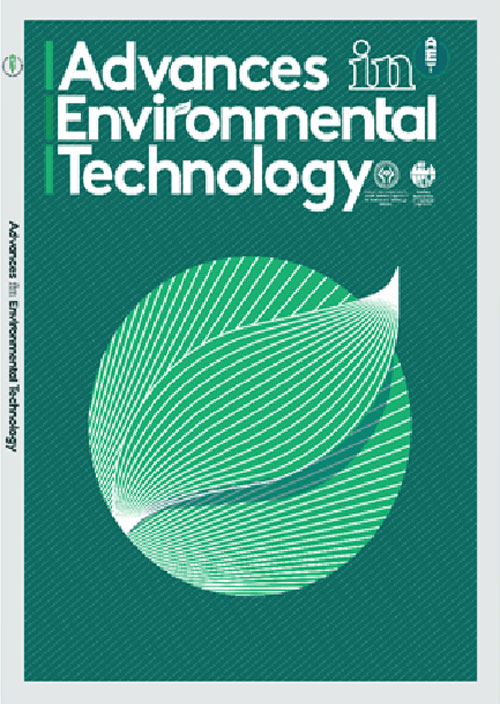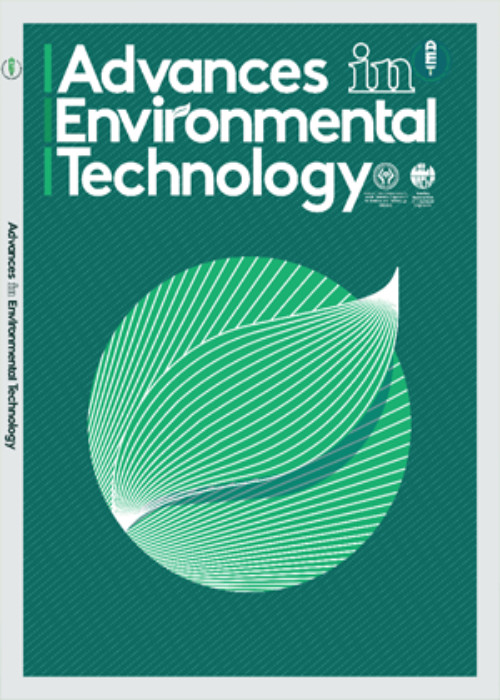فهرست مطالب

Advances in Environmental Technology
Volume:8 Issue: 1, Winter 2022
- تاریخ انتشار: 1401/02/27
- تعداد عناوین: 6
-
-
Study on the degradation of dicofol via electrochemical oxidation process: simulation and validationPages 1-14In this work, the preparation and characterization of an iridium coated titanium anode (Ti/IrO2) and a ruthenium coated titanium anode (Ti/RuO2) for dicofol (DZ) degradation is examined using the electrochemical oxidation process (EO). X-ray diffraction (XRD) and scanning electron microscope (SEM) are used to characterize the metal oxide-coated anodes. The operating parameters in EO, including current density, electrolyte (NaCl) dose, pH, and electrolysis time for the degradation of dicofol, are studied in detail. Box-Behnken response surface design (BBD) incorporated in response surface methodology (RSM) is used to optimize and model the dicofol degradation process. The dicofol degradation and electrical energy consumption are taken as responses. Numerical optimization is used to determine the optimal conditions (current density of 0.1 A/m2, electrolyte dose of 3.5 mM, pH of 7, and electrolysis time of 8 min). Ninety-three percent of dicofol is degraded with an electrical energy consumption value of 0.75 KWh/m3 using Ti/IrO2 anode under optimal conditions.Keywords: Dicofol, Electrochemical process, metal oxide coated anodes, Ti, IrO2, Ti, RuO2, SEM
-
Pages 15-29Ammonium (NH4+), one of the most common types of reactive form of nitrogen in wastewater, can cause eutrophication and other environmental problems if released into waterways. This study was conducted to understand NH4+ adsorption mechanism of wood biochar from municipal green waste in an aqueous environment and the factors affecting NH4+ removal. The biochars were produced by pyrolyzing green wood waste at 300°C (WB300), 450°C (WB400), and 600°C (WB600), respectively. Biochar dosage, pH, and contact duration were studied during NH4+ adsorption studies to see how these variables affected the adsorption process. The adsorption process was studied using isotherms and kinetic adsorption models. The batch equilibrium and kinetic studies at 25°C, pH 7, and a contact duration of 240 minutes showed that the WB450 dosage of 0.2 g/L removed the most (NH4+-N) compared to WB600 and WB300. WB450 had higher affinity values and a maximum adsorption capacity of 2.34 mg/g; the ‘Freundlich isotherm’ model had a better fit to the equilibrium experimental data, indicating that heterogeneous sorption was preferable to monolayer sorption. Chemisorption was the dominant (NH4+) adsorption method, as demonstrated by the ‘pseudo-second-order’ kinetic model with an R2 of 0.99. The study concludes that municipal green wood waste-based biochar can be efficient absorbents for NH4+ removal from wastewater. Also, the removal efficiency can be optimized by selecting different feedstocks or the pyrolysis condition for biochar production.Keywords: ammonium nitrogen, adsorption process. municipal green waste, slow pyrolysis, wood biochar
-
Pages 31-46In this research, a modified TiO2/Bentonite (Be) composite with various values of zinc oxide was used as a photocatalyst in the degradation of methyl orange as a dye pollutant. The synthesized composites were characterized by X-ray diffraction (XRD), Field emission scanning electron microscopy (FESEM), Fourier transform infrared spectroscopy (FTIR), X-ray fluorescence (XRF), and Thermal gravimetric analysis (TGA). The results showed that the composite synthesized by 6.5% zinc oxide had the highest anatase phase and appropriate thermal stability. Moreover, the simultaneous effect of different parameters was investigated using the central composite (CC) design defined under response surface methodology (RSM). The results showed that the polynomial model obtained from the analysis of variance (ANOVA) correctly predicted the experimental data. The optimal conditions of dye degradation for the synthesized composite with 6.5% zinc oxide using 4 g/L of photocatalyst for 30 minutes at a pH=5 and a dye concentration of 20 ppm had the highest degradation percentage equal to 95% with a high desirability of 0.981. Also, the photocatalytic activity of TiO2/Be/ZnO (6.5%) in certain conditions for reuse in five consecutive steps showed a slight decrease in the degradation of methyl orange.Keywords: TiO2, Bentonite, zinc oxide, Methyl orange, Response surface methodology
-
Pages 47-56Dissolved ozone (O3(aq)) and residual ozone in groundwater under differently controlled parameters are two important outcomes in a lab-scale system of ferrous treatment with ozone, but they have not been well investigated yet. In this study, several preliminary parameters of ozone generation, types of diffusers, hydraulic retention time, and the pH in an ozone system of laboratory treatment were examined and evaluated statistically. The results showed that a venturi injector coupled with a bubble diffuser increased O3(aq) concentration to 9.05±0.28 mg/L corresponding to its diffusive coefficient of 0.195 min-1, 2.6 times higher than the bubble diffuser only. The O3(aq) decay constant in the presence of ferrous was 4.88 times higher than that in its absence. The mole stoichiometry of (D[O3(aq)]/D[Fe2+]) in synthetic water during ozonation was 1.21, corresponding to its mass ratio of 1.04 mg O3(aq)/mg Fe2+. The highest efficacy of ozone on ferrous removal was achieved at pH4.0, followed by that at pH6.0; the residual iron concentration at pH6.0 was 0.230±0.149 mg/L, falling below the WHO standard for drinking water. The residual ozone at pH 4.0 and 6.0 was not statistically different and may take 186 and 300 hrs. to achieve EPA and FDA regulations, respectively. The obtained results may provide a system and information of ozone conditions applied in the treatment of iron to meet the maximum standards of iron and ozone in water.Keywords: ozone, Iron Removal, Ozone Diffusion, Water treatment, Lab-scale study
-
Pages 59-71Plastic pollution is a threat to the environment because of its slow degradation rate and high usage. The continuous accumulation of these synthetic plastic wastes poses an ever-increasing threat to animals, humans, and the environment. The use of microorganisms to effectively degrade plastic waste can provide a solution to this problem. This study aims to isolate plastic degrading microorganisms from soils taken from the Alimosho local government area of Lagos State, Nigeria. The soil samples were collected from dumpsites filled with plastic and plastic materials. The effectiveness of the degradation of plastic materials was studied over six (6) weeks in broth and agar culture under laboratory conditions by the weight determination method. Physicochemical and microbiological analysis was carried out on the various soil samples using standard protocols. The biodegradation of polyethylene and polystyrene was done in-vitro using the microorganisms isolated from the soil. The following microorganisms were able to degrade a higher percentage of the plastic materials; Staphylococcus aureus, Streptococcus sp, Bacillus sp, and Escherichia coli. The total viable count for bacteria was within the range of 11.8×105 to 2.0×1010CFU/g. Staphylococcus aureus, Streptococcus sp, Bacillus sp, and Micrococcus sp degraded plastic up to 25%, 31.2%, 25%, and 31.2%, respectively. These isolates may be used to actively degrade plastics, thereby reducing the rate of plastic pollution in our ecosystem.Keywords: Biodegradation, microorganisms, Pollution, Polyethylene, polystyrene
-
Pages 73-81Domestic wastewaters are one of the main sources of contamination and diseases. However, they can be treated and potentially reused if certain organic and inorganic compounds and molecules are eliminated. Novel environmentally friendly proposals are available, such as the use of bioremediation mediated by microalgae capable of efficiently upcycling different quantities of phosphates and nitrates. Thus, in the present study, we evaluated the consumption capacity of nitrates and phosphates present in samples of domestic wastewater by cultures of Chlorella sp. and Desmodesmus sp., two microalgae with nutrient removing abilities, to propose novel wastewater treatment alternatives. For this purpose, we assessed the microalgae growth in domestic wastewater, cultured using the batch system, under greenhouse conditions by reading the wavelength and obtaining the cell density using a multiparameter photometer and two equations for each type of microalgae. Then, the rate and mean percentage of nitrate and phosphate removal were obtained and compared using two previously reported equations applied in similar culture conditions. Both microalgae grew in wastewater samples mostly by day three to four, showing similar growth tendencies without alterations and having a progressive increase in cellular density. Nitrate concentrations in all experimental groups were reduced to up to 90% on the fourth day; the initial phosphate concentration of 30.0 mg/L was reduced to 3.5 ± 2.1 mg/L with the Desmodesmus sp. treatment and to 9.2 ± 1.0 mg/L in the Chlorella sp. group. Desmodesmus sp. was the most efficient in the consumption of nitrates and phosphates, obtaining 96.5 ± 8.91 % and 88.3 ± 4.29 % of removal, respectively, while Chlorella sp. obtained 95.0 ± 8.0% and 69.3 ± 2.8%. Likewise, representative values of removal were obtained with the targets used in the laboratory tests.Keywords: Nitrate, Phosphate, bioreactor, Wastewater treatment


